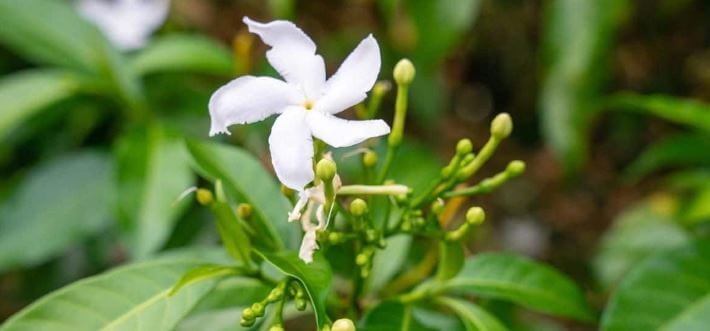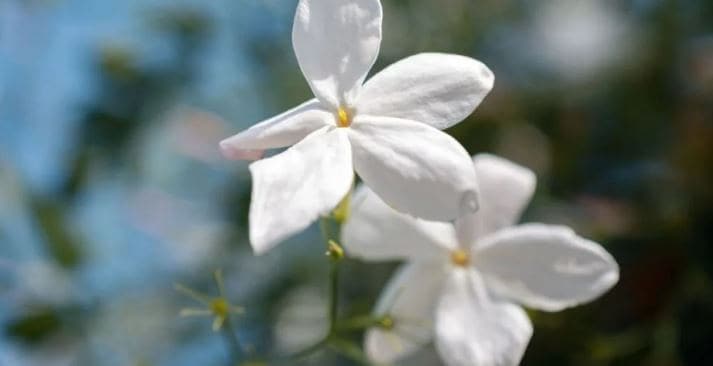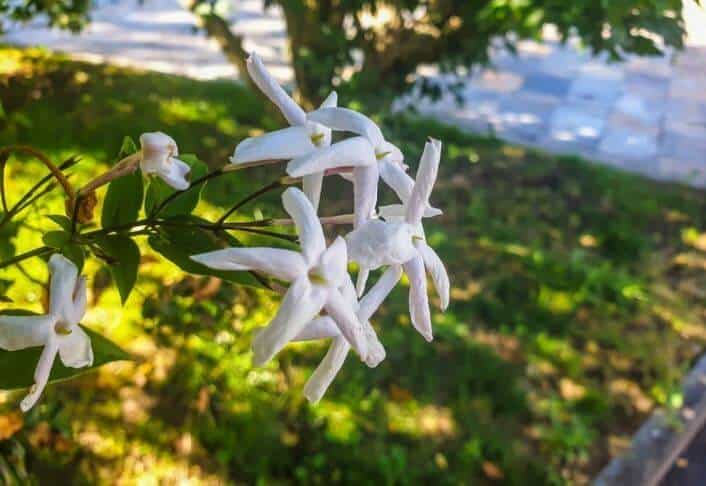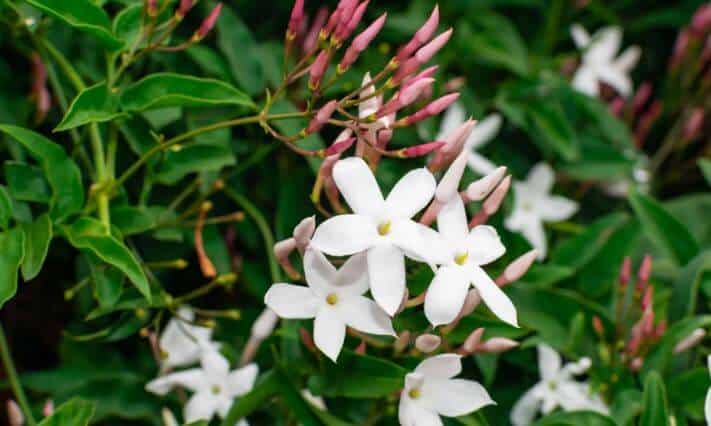Last Updated on June 4, 2023 by a Friendly Gardener
Whether you are looking for a garden plant or a flowering plant that can be container cultivated, The Royal Jasmine is a magnificent, robust, evergreen climbing vine plant. It is easy to care for and can easily be pruned to maintain the desired shape depending on where you position it.
A climbing shrub that is native to the Himalayas, it is botanically known as Jasminum grandiflorum. More commonly known as Royal Jasmine, you may also find it referred to as Smelly, Jasmine, Spanish Jasmine, or Brown Jasmine.
When cultivated outdoors, it can easily reach heights of twenty to forty feet if it has adequate support for its climbing nature. The plant is characterized by a rather dense crown from which sprouts hanging stems. Each stem will feature leaves opposite each other. The leaves themselves are composed of five to nine leaflets that measure just under an inch in length. It can be cultivated outdoors in USDA hardy zones 9 to 11.
But what distinguishes this plant is its lovely white blossoms. White tubular blooms with 5 to 6 lobes each will appear measuring ¾ to 3 inches in length. With good care, your plant may produce up to 50 clusters of these blossoms. Edible blooms are produced from the end of spring to the beginning of fall and are highly perfumed if you wish for a fragrant flowering plant in your home garden.
Royal Jasmine Plant Care

The Royal Jasmine plant is pretty adaptable whether in the garden or for indoor container cultivation if environmental needs are met.
Soil
If cultivating the Royal Jasmine outside in your garden, it is capable of growing in just about any soil type as long as there is sufficient drainage. Indoors for container cultivation, select a quality potting mix and mix two parts with one part perlite. For optimal growth, soil pH should measure between 5.5 to 7.
Light
The one problem that may appear with indoor cultivation is this plant’s need for light. The Royal Jasmine should be placed approximately 2 feet from a sunny window.
It does exceedingly well outdoors because it flourishes with a minimum of six hours of full sunlight daily, so place it in a sunny area where it will receive adequate light. However, check the cultivar you are planting as some do better in partial shade while others need full sun to reach their potential.
Water

Your watering schedule for your Royal Jasmine plant will depend on where you are cultivating it and the climate. Generally speaking, during summer months it will require as much as 3 to 4 waterings weekly, whereas in the cooler seasons it should manage with a watering every 5 days or so.
If you are container cultivating, consider keeping a dish under your flowerpot during the summer months when the heat increases.
Soil should be kept evenly moist but never soggy. Adding a bit of compost will aid moisture retention and drainage. Outdoors consider mulching to maintain soil moisture.
Climbing Support
When choosing a planting location consider that your plant will need climbing support. A wall might be an obvious choice but take care that sunlight is not blocked. It will grow in the direction of the sun unless you train it otherwise. Common support structures include trellises, pre-existing structures, fences, or similar. Structures need to be strong and rust-proof.
When training, do not use permanent ties because your plant may outgrow these. Flexible, soft ties are the best choice.
Temperature

The Royal Jasmine adapts to a variety of climates including temperate to tropical. It can tolerate temperatures as low as 22°F, making it a delightful choice for gardeners in cooler areas. If your area’s climate is cold, consider protecting your plant outdoors with an anti-frost cloth or move the plant indoors to a location with bright light.
Feeding
During the growing season in spring and summer, the Royal Jasmine needs a monthly feed to ensure excellent growth. Ecological fertilizers are the preferred choice including earthworm humus, aged manure, fish emulsion, or similar. Fertilization will contribute to flower production.
If you are container cultivating, use a liquid fertilizer for flowering plants to guarantee continued drainage. Note that using a fertilizer high in nitrogen will promote foliage growth rather than flowering.
Pruning

Broken, weak, and particularly diseased stems should be trimmed off. Ideally, pruning should take place during late spring or the fall season. Use sterilized garden shears when pruning.
Potting, Repotting, or Transplanting
Ideally, the Royal Jasmine should be planted in the spring when outdoor temperatures reach and stay at approximately 60°F.
For container cultivation, plan on repotting your Royal Jasmine at least every second year in a larger pot.
Royal Jasmine Plant Propagation
The Royal Jasmine can be successfully propagated in a variety of ways:
- Seeds
- Stem cuttings
- Offsets
Seed Propagation
Using seeds for propagation is rather uncommon as they do not germinate easily, and they will require several years of maturing before they begin to flower. Should you wish to propagate using seeds, follow these simple steps in the spring:
- Prepare a seeding tray with potting soil and water thoroughly.
- Place several seeds in each tray pocket and cover them with a very thin layer of soil.
- Using a water bottle, spray the seeds.
- Place the tray in a partially shaded location.
- Maintain the goring medium moist so that it never dries out.
- Have patience. Seeds should germinate within one to two months.
- When plantlets appear, they can be transplanted into containers or in your outdoor garden.
Stem Cutting Propagation
Toward the end of summer, trim wood cuttings that are semi-hard and that have leaves. Treat the cut end with rooting hormone and then insert your cuttings in individual pots filled with a quality potting mix. Keep the soil bed evenly damp without overwatering and place the pots in a partially shaded spot. New roots should form within 2 to 3 weeks.
Offsets

The Royal Jasmine plant will produce offsets or suckers at the base of the parent plant. Beginning at the end of summer to winter, remove the offsets with some roots attached and place them in individual pots or other spots in your garden.
Royal Jasmine Plant Problems
The Royal Jasmine is a relatively resistant plant, so it isn’t particularly susceptible to diseases or pest infestations. Nonetheless, it is wise to check periodically for aphids, red spiders, scale, and mealybugs. Mealybugs and scale can be removed manually to some degree. These pests can be contrasted by using organic Neem oil or insecticidal soap.
Diseases that can potentially afflict your plant include Pythium, Phytophthora Root Rot, and Leaf Spot. This happens when the soil contains too much moisture. Stem bases change color and shrink. Foliage will begin to die. These fungal infections can develop if water is contaminated, or the soil is not sterilized.
Leaf Spot is characterized by black or brown spots on foliage. Remove infected leaves and dispose of them. Avoid watering from overhead opting for watering at the plant’s base. Apply a fungicide. Neem oil is also an organic fungicide.
The Royal Jasmine plant is considered to be frost tender.


